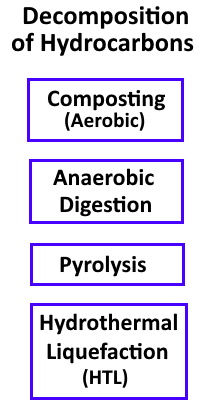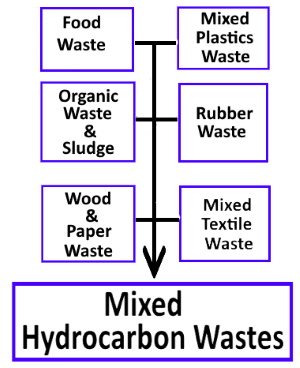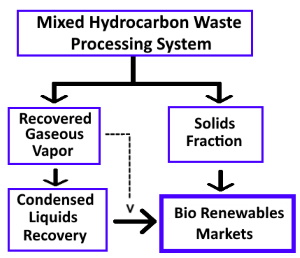
Hydrocarbons
The recovery of Hydrocarbons from a wide variety of
waste
materials creates the opportunity to establish
Urban Oil Wells.
Huge Environmental Sustainability goals may be achieved with the proliferation of a molecular
Hydrocarbon Recovery
process by massively decreasing the disposal of undesirable wastes such as plastics and
by the capture and conservation of
valuable resources.

Hydrocarbon Decomposition
An overview of decomposition methods outline some of the strengths and weaknesses of each different approach.
Composting
Composting
works well for
food wastes
but the primary reduction process and subsequent curing stages
require several months to complete.
Anaerobic Digestion (AD)
Anaerobic Digestion can handle food wastes and
organic sludges
well but is less effective with lignans (wood and paper)
and is not effective with plastics, rubber and textiles.
Degradation occurs faster than natural aerobic composting.
Anaerobic
digestion
is a process through which bacteria breaks down organic matter, such as animal
manure,
wastewater biosolids, and food wastes, in the absence of oxygen.
Anaerobic digestion produces two valuable outputs:
biogas
and
digestate
Food waste
mainly consists of carbohydrates, proteins, lipids, and traces of inorganic compounds.
The carbohydrate content of food waste can include
lignin,
hemicellulose, cellulose, starch, and sugars that can be converted into
bioethanol.
Pyrolysis
Pyrolysis
works well with plastics, rubber, textiles, paper and wood,
pre-treatment is required for food and wet wastes to remove excess moisture.
Hydrothermal Liquefaction (HTL)
Various forms of hydrothermal carbonization (HTC) utilize different combinations of heat and pressure to
achieve the rapid reduction or decomposition of carbonous materials.
Hydrothermal Liquefaction
(HTL)
works well on a broad range of hydrocarbon wastes
and the moisture content of the feed stock does not negatively impact the process since
most HTL systems use water as a catalyst.
The HTL process is fast and both HTL and Pyrolysis can be fueled by a percentage of the
product recovered from the feed stock.

Mixed Hydrocarbon Wastes
The recovery of mixed hydrocarbons is possible by connecting generators
and users of waste materials,
Please feel free to ADD a inquiry to the
Mixed Hydrocarbon Wastes
exchange.
Circular BioEnergy Generator (CBEG)
Any number of events could occur that spark the development of a cottage industry to
own and operate your own Circular BioEnergy Generator (CBEG) or Urban Oil Well by
collecting and converting Hydrocarbon Waste materials into
Bio Crude.
In a decentralized world the establishment of small scale urban oil wells
that may be located close to the source of waste feed stock give cause to rethink potential energy independence.

Chemical Recycling
The current terminology of
Chemical
Recycling or
Molecular
Recycling of plastics
refers to the thermal decomposition of hydrocarbons into a partially reduced, condensed intermediary stage
mixed hydrocarbon raw product known as
Bio Crude
or Bio Oil.
Please take this opportunity to explore
Bio Refining.
Hydrocarbon Splitting
The Recovery 2.0 system embraces the concept of
Hydrocarbon Splitting
in a process where Hydrocarbon gases are
converted into
clean Hydrogen
and
solid carbon.
Depolymerization
In the plastics recycling industry Depolymerization typically refers to the partial decomposition of plastics or polymers
into specific monomers.
It is a common goal to rebuild these refined monomers into complex polymer chain for specific market designations.
This is not the same process as full
Molecular
decomposition.
Depolymerization primarily requires very clean feedstocks and typically can not tolerate contamination,
so this process is not applicable for mixed wastes.
Re-Refining
The refining of hydrocarbons is a well established industry and
the supply of Bio Crude or synthetic crude oils generated from waste recovery projects
is a compatible raw feed stock.
Many newly adopted participants of the Chemical Recycling process seem to share the opinion to
reinvent the wheel by Re-Refining, distilling, cracking and segregating the intermediate oil fractions,
and some feel the need to produce finished petrochemical products to achieve a new form of
energy independence.
Re-Refining is a common method for the recovery of
Used Motor Oil
and other petrochemicals and waste oils.
Hydrocarbon Recovery Information
For anyone seeking current information or research data on Hydrocarbon Recovery,
you may access and ask your
Recycling Questions
to a core group of experienced and knowledgeable recycling industry professionals.
Renewable Natural Gas (RNG)
The decomposition of organic or hydrocarbon based materials liberates a gaseous fraction known as
BioGas.
This type of material is derived from a number of sources including landfill gas, recovered digester gases
and pyrolysis off gasses.
The collection and cleaning of
Renewable Natural Gas (RNG)
or methane CH4 can directly replace Natural Gas and may be sold at a premium price into green markets.
Renewable Natural Gas (RNG) may also be further refined into clean
Hydrogen.
Bio Crude
The Hydrocarbon recovery process captures a liquid fraction of mixed light and heavy bio oils referred to as
Bio Crude.
This material may be sold as is into the open market or be further upgraded by
Re-Refining.
Bio Solids
The solid fraction of materials captured from the Hydrocarbon Recovery process is largely a carbon material,
packaged and sold into the
carbon markets.
As with recovering any waste stream it is important to implement a comprehensive
Residual Materials Management
strategy to deal with the metallic and inorganic inert materials contained in the original raw feed stocks.
Other Hydrocarbon Wastes
Wastes from fossil fuel byproducts,
oil,
gas, coal and petrochemical wastes,
aromatic hydrocarbons,
residues, sludges and pollutants
have spread throughout our air, water and earth.
We have been living in a throwaway society and that strategy must change, we need to adopt a
responsible approach to the stewardship of managing our environment.
Efforts are required for immediate
Hydrocarbon Recovery
and regeneration to obtain environmental equilibrium.
Hydrocarbon Recovery
The complete reduction of signal elementals with the selective recovery of
Carbon
and
Hydrogen
from mixed Hydrocarbon
wastes
can be viewed as an ultimate method of recycling.
The
regenerated
materials are segregate into pure Hydrogen & Carbon commodities
and are directly marketable worldwide.
Hydrocarbon Cycle
The
Recovery 2.0
system attempts to take advantage of a Hydrocarbon Cycle.
The Thermal Reduction of
mixed wastes
that contain largely hydrocarbon based materials are reduced and
split
into Hydrogen and Carbon.
Using a reaction that recombines hydrogen and carbon in the absence of oxygen, the primary energy required to drive the
thermal reduction
process is generated.
As well as heat, this reaction produces a byproduct of
hydrocarbons
which are captured directly into the recovery stream
and the cycle continues.
One of the
Waste.net
objectives is to advance the adoption of waste reduction efforts.
